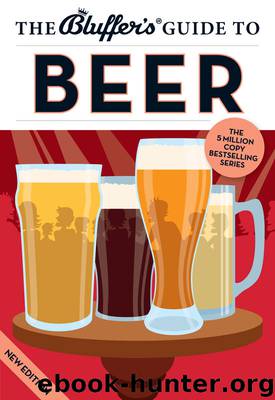The Bluffer's Guide to Beer by Jonathan Goodall

Author:Jonathan Goodall
Language: eng
Format: epub
Publisher: Bluffer's Guides
EIN STEIN
(IS NOT ENOUGH)
GERMAN LAGERS
HELLES
Taking its cue from the original golden Pilsner, created in Pilsen, Bohemia, in 1842, helles was first brewed at Munich’s Spaten brewery in 1894, making it probably Germany’s first golden lager. Also known as ‘Munich original lager’, helles is the everyday, go-to brew for Münchners in search of a good time. It’s the fizzy Bavarian blonde that launched a thousand lederhosen; and still launches them nightly in Munich’s heaving biergartens.
Hell means ‘light’, but don’t let that fool you, as this really refers to the beer’s colour. Helles is indeed a refined, quaffable thirst-quencher, but it can be quite full-bodied with plenty of malt and floral hop character. German golden lagers (hell, let’s call them Pilsners) tend to have a drier, leaner and paler malt profile than their Bohemian brethren, leading to a more pronounced, assertive bitterness, don’t you find?
At 5.2% ABV, Augustiner Helles is a brand that Münchners hold dear. It’s made in Munich’s oldest, still-independent brewery, and is famous locally for its refusal to advertise. It is held aloft in brimming, swaying steins, not by a massive ad spend, but by the love of the locals.
MÄRZEN AND OKTOBERFESTBIER
In the days before refrigeration, Bavarian brewers would stockpile strong, heavily hopped beers in the spring and store them in cold caves and cellars through the hot summer months for autumn/winter drinking. Thus, these full-bodied, off-dry, malty beers were often brewed in March (März) and cracked open in October (Oktober) amid wild celebrations. This is how the world’s biggest beer festival, Munich’s Oktoberfest, was born. If you plan to attend, and hope to sound as if you know something about German beer, you’ll need most of the information in this chapter.
Märzen and Oktoberfestbier derive their warm copper-red colours from amber malts, sometimes called ‘Vienna malt’ in reference to the off-dry, reddish beers once brewed in that city. This is yet another style enjoying a revival among US craft brewers. Hacker-Pschorr Oktoberfest Märzen (5.8%), balancing sweet, smooth maltiness with a touch of crisp hop bitterness, is a fine example of this seasonal session beer.
DUNKEL AND SCHWARZBIER
We’ve lumped dunkels and schwarzbiers together because they’re both dark beers, but do not make the schoolboy error of confusing the two. Dunkel means ‘dark’ and is used as a prefix to describe a whole range of German beers. These are mostly lagers, but then most German beers are lagers. For example, you might also encounter a dunkel hefeweizen, a dark wheat beer, which is, of course, an ale. Schwarzbier, on the other hand, translates as ‘black beer’ and is, specifically, a style of lager. As a rule of thumb, schwarzbiers are darker than dunkels. But while they are blacker and more opaque, schwarzbiers also tend to be drier and lighter-bodied. Their easy-drinking style is not what you might expect from their inky colour scheme. Köstritzer Schwarzbier (4.8%) looks rather like a stout and is typical of the light schwarzbier style.
The best-known dunkel lager is Münchner dunkel which, before fancy-schmancy golden helles came knocking, was the everyday beer of Bavaria.
Download
This site does not store any files on its server. We only index and link to content provided by other sites. Please contact the content providers to delete copyright contents if any and email us, we'll remove relevant links or contents immediately.
| Coloring Books for Grown-Ups | Humor |
| Movies | Performing Arts |
| Pop Culture | Puzzles & Games |
| Radio | Sheet Music & Scores |
| Television | Trivia & Fun Facts |
Spell It Out by David Crystal(36039)
Professional Troublemaker by Luvvie Ajayi Jones(29588)
We're Going to Need More Wine by Gabrielle Union(18967)
The Secret History by Donna Tartt(18843)
Cat's cradle by Kurt Vonnegut(15182)
The Goal (Off-Campus #4) by Elle Kennedy(13542)
The Social Justice Warrior Handbook by Lisa De Pasquale(12141)
The Break by Marian Keyes(9306)
Crazy Rich Asians by Kevin Kwan(9167)
The remains of the day by Kazuo Ishiguro(8818)
Thirteen Reasons Why by Jay Asher(8792)
Educated by Tara Westover(7940)
The handmaid's tale by Margaret Atwood(7678)
Giovanni's Room by James Baldwin(7189)
Win Bigly by Scott Adams(7094)
This Is How You Lose Her by Junot Diaz(6792)
The Rosie Project by Graeme Simsion(6188)
Six Wakes by Mur Lafferty(6146)
The Power of Now: A Guide to Spiritual Enlightenment by Eckhart Tolle(5604)
